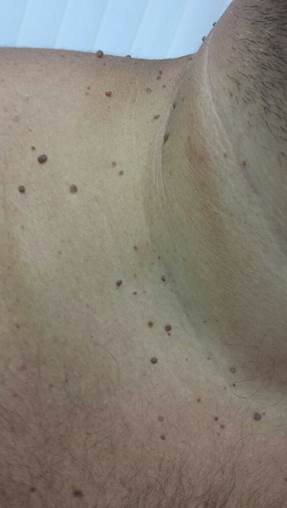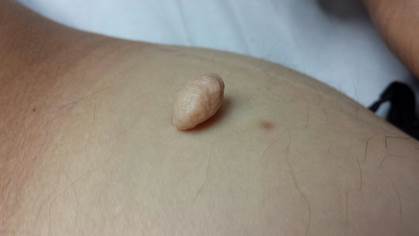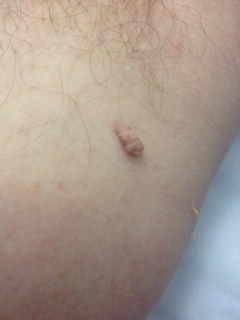ACROCHORDON
Luciano Schiazza M.D.
Dermatologist
c/o InMedica - Centro Medico Polispecialistico
Largo XII Ottobre 62
cell 335.655.97.70 - office 010 5701818
www.lucianoschiazza.it
AAn acrochordon (plural acrochorda or acrochordons) also known as skin tag is a common, small, soft, harmless, usually pedunculated tumor, completely benign, that is often raised from the surface of the skin on a thin fleshy piece of tissue called a peduncle or stalk: it looks like a small soft, balloon of hanging skin. It is skin colored or hyperpigmented, varies in size from 1-5 mm in diameter (it is tipically the size of a grain of rice), but sometimes acrochorda may become as large as large as big grape (1 cm in diameter) or a fig (5 cm in diameter).
Acrochordon is recognized easily by looking at it.

Acrochordon may occur singly or multiply (even hundreds) and typically occurs in characteristic friction locations where skin rubs against skin or clothing, primarily in areas where the skin forms creases, such as neck, armpit (axillae) (the two most common areas), groin, beneath the female breasts, buttock folds, or in the genital region. They may also occur on the face, usually on the eyelids.
Skin tags are not skin cancers (malignant) and cannot turn into skin cancers if left untreated. But on extremely rare instances, histologic examinationof a clinically diagnosed acrochordon reveals a basal or squamous cell carcinoma.
Acrochondron-like bump that bleeds, grows, is larger, atypical, has an unusual presentation, is too firm to be wiggled easily, is a different color than surrounding skin, display multiple colors (like pink, brown, red, or black) can require a biopsy to exclude other causes like skin cancer. But on rare occasions, histologic examination of a clinically Skin tags typically appear equally in men and women as they age (they are acquired and are not present at birth) and more than half of the general population has been reported to have skin tags at some time in their lives.
They are more common in middle age and tend to increase in people 60 and older and often develop after weight gain or pregnancy. A tendency to develop acrochorda may run in families: a causal genetic component is thought to exist.
They tend to be more numerous in overweight, obese persons (statistically significant relationship with) and in those with type 2 diabetes mellitus. Hormone elevations, such as those seen during pregnancy, may cause an increase in the formation of acrochorda, as skin tags are more frequent in pregnant women. Human papillomavirus (HPV) types 6/11 DNA were also found in some of skin tag biopsy samples. Viral infection should be considered as a pathogenic cofactor. The surface of an acrochordon may be smooth or irregular in appearance.
They are also described as:

- Papillomas
- Hanging mole
- Fibroepithelial polyps (FEPs)
- Soft fibromas
- Pedunculated (this means they are on a stalk)
- Filiform (this means they are thread-like)
Three types of acrochordons are described, as follows:
- Small, furrowed papules of approximately 1-2 mm in width and height,located mostly on the neck and the axillae
- Single or multiple filiform lesions of approximately 2 mm in width and 5 mm in length occurring elsewhere on the body
- Large, pedunculated tumor or nevoid, baglike, soft fibromas that occur on the lower part of the trunk

These tumors are usually asymptomatic and typically painless, and do not grow or change over time. However, if they are in an area where clothing or jewelry rubs repeatedly against them or in the groin, they can become inflamed or irritated and patients may complain of physical pain or discomfort and they may be unsightly.
Very large skin tags may burst under pressure. Occasionally, a tag may spontaneously fall off without any pain or discomfort. This may occur after the tag has twisted on itself at the stalk base, interrupting the blood flow to the tag.
A thrombosed or clotted acrochordon (from twisting) may suddenly change colors, becoming purple, black (from necrosis for death of the skin tissue), and irritated when its blood supply is inadequate. Thrombosed skin tags typically may fall off on their own in three to 10 days and don't require additional treatment.
Rarely, they can be described in the Birt-Hogg-Dubé syndrome (associated with fibrofolliculomas and trichodiscomas) and the polycystic ovary syndrome. Microscopically, an acrochordon consists of a fibro-vascular core (loosely arranged collagen fibres, many capillaries, sometimes also with fat cells), covered by a thickend or thinned-out epidermis.
Some common skin conditions that can mimic skin tags include
- Neurofibromatosis
- Nevi, Melanocytic
- Premalignant Fibroepithelial Tumor (Pinkus Tumor)
- Seborrheic Keratosis (so-called "Rice Krispies”)
- Warts, Genital
- Warts, Nongenital
- Nevus lipomatosus
- Milia
Rarely, skin cancers like basal cell carcinoma, squamous cell carcinoma, and malignant melanoma may mimic acrochorda. Because skin tags are benign, not contagious, treatment is unnecessary.
The most common reason they are removed is for cosmetic concern because of unsightly appearance. Sometimes, they may become snagged by clothing, jewelry, pets, or seat belts, causing pain or discomfort and for this reason may require removal. If removal is desired or warranted, a dermatologist may use cauterization or electro-desiccation, cryosrgery, ligation (a suture, a piece of dental floss or thread is tied around the neck of the skin tag) or snipping with sharp scissors, or a sharp blade.
There are no currently medically approved creams for the removal of skin tags. There is no evidence that removing a skin tag will cause more tags to grow and there is no way to prevent skin tags.
